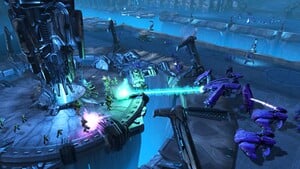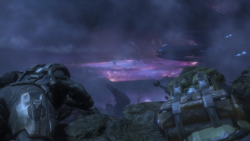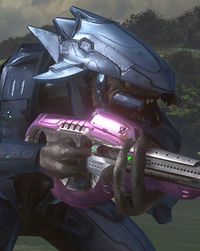Covenant military
From Halopedia, the Halo wiki
| This article does not have enough inline citations and/or does not adhere to the proper citation format. You can help Halopedia by adding citations. |

The Covenant maintained a pervasive military force which it used to carry out the Hierarchs' will throughout the Covenant's vast empire. Rather than being a singular organization, the Covenant's military forces were a collection of organizations under the oversight of various political bodies, which in turn carried out the edicts of the High Council.[1] The Sangheili originally served as the leadership caste for the Covenant's various armed forces, until they were replaced by the Jiralhanae during the Great Schism.[2]
History

In the early centuries of the Covenant, the Writ of Union established the armed forces of the Sangheili as the hegemony's sole military force, with the San'Shyuum having little part in its day-to-day operation. The military's original purpose was to allow the Covenant to establish dominance in the Milky Way by force, but its primary goal was to acquire Forerunner technology and to bring forth the Great Journey. The fact that the Covenant military, the empire's largest and most powerful entity, was completely under the control of Sangheili led to some San'Shyuum distrusting the species.[2] One of the Covenant military's earliest engagements was during the Rending, an insurrection led by Ussa 'Xellus.[3] As the Covenant conquered and assimilated various species for its cause, members of each race were incorporated into the Covenant military to perform different roles, adding their own unique advantages and disadvantages. The Unggoy Rebellion in 2462 ushered in a major restructuring of the military: because they had proven themselves in combat in the eyes of the Sangheili, the Unggoy were allowed into formerly Sangheili-only units and were given better weaponry, giving rise to the Unggoy as a proper infantry class.[4]
During the Great Schism, the Covenant military was violently torn between those who continued to follow the High Prophets, and the Sangheili who had been cast out of the Covenant along with those loyal to them.[5] As the battle raged, the High Prophet of Truth formally transferred command of the military to the Jiralhanae, a position once exclusively held by the Sangheili. Following the Schism, the Flood outbreak on High Charity and the eventual destruction of the remaining Covenant leadership in the Battle of Installation 00,[6] the Covenant military ceased to exist as a functioning force due to the absence of a structured Covenant government.
A number of splinter factions formed in the wake of the Covenant's destruction. Members of the former Covenant who followed Arbiter Thel 'Vadam banded together to form the Swords of Sanghelios. However, several other groups took up arms against the Swords, including the Servants of the Abiding Truth and later a new Covenant led by Jul 'Mdama. These groups have marshaled significant amounts of the Covenant's former matériel and troops while maintaining the practices and traditions of the former Covenant's military forces to varying degrees.[7]
Organization
Political oversight
The Covenant's military was made up of a variety of martial organizations under the control or influence of one or more governmental ministries.[1] Politically, most of the military fell under the jurisdiction of the Ministry of Resolution,[8] while some of the more specialized military forces were overseen by different ministries, such as the Ministry of Fervent Intercession in the Zealots' case.[9] The Ministry of Tranquility was granted military assets to aid in the ministry's function: the acquisition of Forerunner relics. However, ships of the Ministry of Tranquility rarely participated in fleet action.[1] The Ministry of Preservation had some oversight in the military, as the ministry was tasked with quelling internal rebellions and uprisings.[10] The Ministry of Abnegation likely had some authority in the military, as the ministry absorbed the Ascetics' guard.[11] Like the rest of the Covenant, the Covenant military was under the ultimate jurisdiction of the High Council,[12] formerly composed of Sangheili High Councilors who oversaw the operation of the military.
The Council of Deed and Doctrine was a command organization within the Covenant military and aided the Hierarchs with military tactics and strategy. During major conflicts, the Council of Deed and Doctrine created a Council of Masters to directly oversee operations.[citation needed] The San'Shyuum and Sangheili members of the Council of Masters sent Sangheili soldiers into battle and dictated war needs. Because San'Shyuum did not hold military ranks, no San'Shyuum was truly a "member" of the military. Instead, they were responsible for strategic decision-making, but also traveled with Covenant military units as religious or political overseers.[13][14]
Military organization
The Covenant military was heavily naval-oriented, with fleets ranging from small battle groups to entire armadas serving as the basic unit of organization. These fleets appeared to be under the direct authority of a given ministry,[8] and there was seemingly no meaningful distinction between service branches, such as the human notions of a dedicated "navy" and "army"; for example, field officers, including Sangheili Generals, could command ground operations as well as starships.[15] Individual fleets operated a number of task-based groups, including the ground-oriented Occupational Forces[16] and the Special Warfare Group, which contained the Special Operations Division.[8]
The Covenant military was organized based on the Covenant's caste system. The officer corps was primarily staffed by Jiralhanae (and formerly by Sangheili),[17] while the Unggoy and Kig-Yar generally filled menial or infantry roles. Ranks were denoted by the color, type of armor and accessories worn for Sangheili, Jiralhanae and Unggoy; different ranks of Kig-Yar would also be distinguished by the color of their shield gauntlets.
The smallest organizational unit of the Covenant military was file, typically consisting of cannon fodder Unggoy. A lance was a small unit of Unggoy commanded by a low-ranked Sangheili (later Jiralhanae), a rough equivalent to a UNSC fireteam. Jiralhanae were also organized into the tribal packs traditional of their society. Large numbers of these units comprised legions, which were organized into task-based groups within their respective naval fleets.
Species
Despite the diversity of their weapons and forces, Covenant troops are heavily segregated. Unggoy are deployed as cannon fodder, Kig-Yar are used as support and snipers, and Sangheili are commanders and fight in warrior lances. Weapons and technology are restricted by species and rank; only Sangheili receive personal energy shields and energy swords, only Kig-Yar receive point defense gauntlets, and Unggoy only receive basic weapons and armor, depending by rank.
The reasons for these restrictions are often cultural; for instance, Sangheili view wielding shield gauntlets as dishonorable and that "lesser species" do not deserve their privileged weapons. The Covenant's interspecies politics also played a large part in this segregation: while Sangheili-led mixed units existed, the Sangheili and the Jiralhanae often maintained their own individual command hierarchies largely segregated from one another to prevent conflict and authority issues from arising between the two. It was originally rare for the Jiralhanae to receive their own ships to begin with, and the ones given to them by the Sangheili were smaller and less powerful while the Sangheili maintained the bulk of the Covenant's fleet.[18] When the Jiralhanae were made the Covenant's main military caste, their indigenous weaponry and vehicles—equally brutal in design and function—became a staple on the battlefield alongside the Covenant's more refined technologies.[6]
This discrimination among the Covenant military is centuries old, but the dynamic is occasionally changed by violent rebellion. The Unggoy Rebellion caused Elites to mix their units with Grunts and give them better training. Likewise, the Great Schism put Jiralhanae in command of former Sangheili units, gave them personal shielded armor, and made Jiralhanae packs a prevalent unit within the military in addition to the mixed-species lance.
- Sangheili - dominant military caste prior to the Covenant Schism; field commanders and elite warriors
- Jiralhanae - dominant military caste following the Covenant Schism; previously shock troops
- Mgalekgolo - shock infantry, heavy-weapons platforms
- Yanme'e - airborne infantry, combat engineers
- Kig-Yar - scouts/snipers, police force
- Skirmishers - shock infantry
- Unggoy - majority of infantry, cannon-fodder
- Huragok - combat engineers, medics, suicide bombers
Structure
- High Council
- Covenant Honor Guard
- Ministry of Resolution — oversight of most military operations and fleets
- Fleet — basic organizational unit
- Occupational Forces — land-based troop contingents[16]
- Legion
- Special Warfare Group
- Fleet — basic organizational unit
- Ministry of Fervent Intercession — oversight of the Sangheili Zealot corps
- Ministry of Preservation — dealt with internal dissent and rebellions
- Ministry of Abnegation
Rank structure
| Classes | Sangheili | Unggoy | Huragok | Lekgolo | Jiralhanae | Kig-Yar | T'vaoan | Yanme'e |
|---|---|---|---|---|---|---|---|---|
| Ranks and type classes | ||||||||
| Standard ranks | Minor | Minor | Mgalekgolo | Minor | Minor | Minor | Minor | |
| Specialized troops | Ranger Spec Ops Stealth Ossoona Honor Guardsman |
Heavy Spec Ops |
Scarab | Stalker Jumper Bodyguard Honor Guardsman |
Sniper Ranger |
Commando | ||
| Veterans | Major Spec Ops Officer |
Major | Major | Major | Major Murmillo |
Major | ||
| Leaders | Ultra Lights of Sanghelios Field Commander General Zealot |
Ultra | Ultra Captain Captain Major Captain Ultra |
Zealot | Champion | Ultra Leader | ||
| Titles | ||||||||
| Ratings | Shipmaster Spec Ops Commander Fleet Master Field Master Field Marshal Supreme Commander Imperial Admiral Councilor Arbiter |
Shipmaster Fleet Master Chieftain War Chieftain Chieftain of the Jiralhanae |
Shipmaster | Shipmaster | ||||
Known units
Fleets
- Main article: Covenant fleet
| |||||||||||||
Legions
- Main article: Legion
Military assets
The Covenant military maintained a vast array of military equipment, vehicles and weaponry, most of which fell into the hands of its remnant factions after the hegemony's fragmentation. Troops were delivered from ships into the battlefield via Type-25 Spirit or Type-52 Phantom dropships and various types of drop pod. The Type-32 Ghost serves as a common scouting vehicle, the mainstay battle tank is known as the Type-26 Wraith, with air support provided by the ubiquitous Type-26 Banshee. Most of the Covenant's vehicles employ anti-gravity technology in some form.
 This section needs expansion. You can help Halopedia by expanding it.
This section needs expansion. You can help Halopedia by expanding it.
Gallery
- HR - Covenant armada.jpg
Concept art of a Covenant army for Halo: Reach.
List of appearances
Sources
- ^ a b c Halo: Fleet Battles, Core Rulebook - page 7
- ^ a b Halo Waypoint: Covenant
- ^ Halo: Broken Circle, pages 178-181 (Google Play edition)
- ^ Halo: Contact Harvest, page 151
- ^ Halo 2, campaign level Uprising
- ^ a b Halo 3
- ^ Halo 4
- ^ a b c Halo: The Essential Visual Guide, pages 10, 11, 175
- ^ Halo: The Essential Visual Guide, page 60
- ^ Halo: The Essential Visual Guide, page 10
- ^ Halo: The Essential Visual Guide, page 56
- ^ Halo: The Flood, page ??
- ^ Halo: The Flood
- ^ Halo: The Cole Protocol, page 144
- ^ Halo: Reach, campaign level Long Night of Solace
- ^ a b Halo: The Essential Visual Guide, page 57
- ^ Bungie.net: Type-25 Directed Energy Rifle
- ^ Halo: Contact Harvest, pages 195, 199
